二维光电探测器光电调节特性的机理与验证
IF 2.4
4区 工程技术
Q3 ENGINEERING, ELECTRICAL & ELECTRONIC
引用次数: 0
摘要
二维光电探测器具有通过调节费米能级来提高光学效果的重要特性,在可见-红外光电探测领域具有突出的发展前景。本文结合二维材料的表面电子特性,分析了基于二维材料的光电探测器光电效应的物理机制。通过模拟不同波长的光波照射在光电探测器表面,分析其电导率和吸收率的变化。由于通道材料具有电可调谐的费米能级,因此表面电场也将随费米能级而调节。最后,我们通过制备三层石墨烯器件来验证其光电性能。结果表明,三层石墨烯光电探测器的光响应在1550 nm处达到最大值,表面光电电场分布受费米能级调节的影响。研究结果表明,石墨烯光电探测器的性能可以通过费米能级进行有效调控,为未来光电探测器的性能提升和材料升级提供了理论支持。本文章由计算机程序翻译,如有差异,请以英文原文为准。
Mechanism and Verification of Photoelectric Regulation Characteristics of Two-Dimensional Photodetectors
Two-dimensional photodetectors have an important property that can improve the optical effect by adjusting the Fermi level, and have outstanding development prospects in the field of visible-infrared photoelectric detection. Here, combined with the surface electronic properties of two-dimensional materials, we analyzed the physical mechanism of the photoelectric effect of a photodetector based on two-dimensional materials. By simulating the light waves of different wavelengths induced on the surface of the photodetector, the changes of its conductivity and absorption rate were analyzed. Since the channel material has an electrically tunable Fermi level, the surface electric field will also be regulated with the Fermi level. Finally, we verified its photoelectric performance by preparing a trilayer graphene device. The results show that the light response of the trilayer graphene photodetector reaches the maximum at 1550 nm, and the surface photoelectric electric field distribution is affected by the Fermi level regulation. Our results show that the performance of graphene photodetectors can be efficiently regulated by Fermi level, which provides theoretical support for the performance improvement and material upgrading of photodetectors in the future.
求助全文
通过发布文献求助,成功后即可免费获取论文全文。
去求助
来源期刊

IEEE Photonics Journal
ENGINEERING, ELECTRICAL & ELECTRONIC-OPTICS
CiteScore
4.50
自引率
8.30%
发文量
489
审稿时长
1.4 months
期刊介绍:
Breakthroughs in the generation of light and in its control and utilization have given rise to the field of Photonics, a rapidly expanding area of science and technology with major technological and economic impact. Photonics integrates quantum electronics and optics to accelerate progress in the generation of novel photon sources and in their utilization in emerging applications at the micro and nano scales spanning from the far-infrared/THz to the x-ray region of the electromagnetic spectrum. IEEE Photonics Journal is an online-only journal dedicated to the rapid disclosure of top-quality peer-reviewed research at the forefront of all areas of photonics. Contributions addressing issues ranging from fundamental understanding to emerging technologies and applications are within the scope of the Journal. The Journal includes topics in: Photon sources from far infrared to X-rays, Photonics materials and engineered photonic structures, Integrated optics and optoelectronic, Ultrafast, attosecond, high field and short wavelength photonics, Biophotonics, including DNA photonics, Nanophotonics, Magnetophotonics, Fundamentals of light propagation and interaction; nonlinear effects, Optical data storage, Fiber optics and optical communications devices, systems, and technologies, Micro Opto Electro Mechanical Systems (MOEMS), Microwave photonics, Optical Sensors.
 求助内容:
求助内容: 应助结果提醒方式:
应助结果提醒方式:


